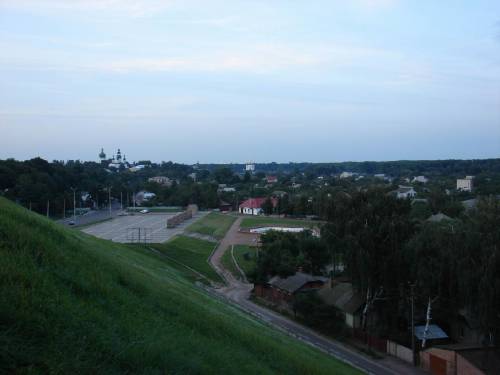 To the west of historical center of our city the slopes of Boldyn Hills rise.
To the west of historical center of our city the slopes of Boldyn Hills rise. They are the highest place in Chernihiv. Boldyn Hills is the right high bank of the Desna river, which originates to the after boulder-period, when basic banks were formed. The name of this area originates from the Old Russian word “bold”, which means oak. For Slav-pagans oak was considered a sainted tree, that is why there is an idea, that in those times here was the Saint oak ravine and pagan temple, but archaeologists hasn’t found it. A few oaks, as the witnesses of remoteness, were saved to our time. Today they are from 200 to 400 years. This locality has the annalistic mention under 1069. It was connected with foundation a Bohorodychnuy monastery by Russ monk Anthony here. “Anthony loved the Boldyn Hills and settled here”.
In Old Russian pre-Christian times a city burial mound cemetery was located in this place. On the territory of modern Chernihiv a lot of burial mounds remained, but a group of Boldyn Hills is the biggest among them. Besides, this burial mound necropolis is one of two that were saved within the borders of the city on the territory of Old Russ.
Till nowadays only the southern part of the necropolis remained, the northern part was built-up in post-war years. Research of burial mounds was conducted in early 70s of the 19th century by a professor D. Samokvasov from Moscow. He numbered 232 burial mounds, 118 of them he dug out. Except differences of burial mounds in size, they also differ in burial ceremony. In all small burial mounds burials are done in grave pits.
They are burial places of simple people, almost all of them contained no material things, only some decorations were found in 20 burial mounds (rings, beads). Two large burial mounds attract special attention: Hul’byshche and Bezimennyi, where princely men-at-arms were buried. These burials are already done according to the cremation ceremony. Broadly speaking the burial ceremony in large burial mounds is alike with description of the Arabic traveller and writer of the 10th century Ibn-Fadlana.
First at future burial place a small addition was done where a coffin for the dead person was built where the things he had used during his life were put: tableware, meal, decorations, trappings and guns, if he was a warrior. The most beloved woman-concubine was also killed. Sometimes women consented to be killed, not to be with unloved person during this life. The war-horse was killed. In presentation of Slavs the other world was similar to the real. Then a coffin was set on a fire and all of it was burned out in a fire. It was considered that the higher smoke rose in mid air, the higher place he who was burned will occupy in the heaven. When a fire burned down, poured a small burial mound on which a funeral feast on a dead person was produced, where a final burial mound was poured upon. The higher social status the person had the higher mound was poured on.
After the research burial mound Hul’byshche became well-known because there was found the military weapon of big size. Among them was the biggest sword known from all Old Russian ones – 126 cm.
Thus, from those old times, Boldyn Hills became traditional burial places of well-known people, whose names are related to our city. Here is a grave of the famous Ukrainian specialist in folklore and ethnographer O.V. Markovych, Marco Vovchok’s husband.
He was born in Poltava and was deported to Russia to Orel city for participating in Kyrylo and Methodiy society. There he became acquainted with his future wife – Maria Vilenska. After the permission to return to Ukraine, he lived with his wife in Chernihiv. She began her literary career here.
A small ravine dissociates the grave of O. Markovych from a burial-place of a great Ukrainian writer M. Kotsiubynskyi. Fifteen years the writer lived in our town. He wrote the best works here, such as “Fata Morgana”, in which he described the revolutionary events of 1905-1907. The writer died in 1913. He chose a burial-place itself. M. Kotsiubynskyi entrusted to bury him on his favourite resting-place under the oak on a hill, where the magic view is opened on the Desna river and ancient Podil. Afterwards, his wife V.U.Kotsubinska was buried near him.
At the edge of Boldyn Hill cape, alongside with the burial places of Slavonic warriors there is a grave of Unknown soldier, warrior who gave his life in the Great Patriotic War. When battles for capturing our city by fascist invaders were being fought, a woman of Chernihiv reburied four lost soldiers in the garden. In 1967 graves were opened, the names of three were found, they were buried in brotherly grave. The name of the fourth remained unknown. He was buried here on the Chernihiv’s highest place. To commemorate all the warriors who were lost on the fronts of Great Patriotic War the Eternal fire was inflamed in 1967.
But Boldyn Hills are not just a necropolis, it is a favourite resting-place for city guests and inhabitants. Those who are walking here can’t but see an arbour by the hill. It was put here in 1911 in honour of His Emperor's Majesty tsar Mykola the II’s arrival to our city. A tea ceremony with marvellous view was planned for him here. But it did not take place and an arbour remained for descendants as a romantic place. Probably such was those visitors’ mood who named it “Love arbour”.
Such a strange, memorable and sainted place are Boldyn Hills in Chernihiv.





























